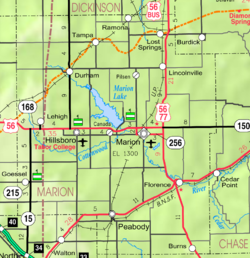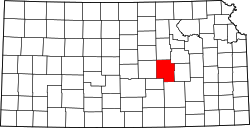2010 census
As of the census [12] of 2010, there were 112 people, 48 households, and 27 families residing in the city. The population density was 622.2 inhabitants per square mile (240.2/km2). There were 67 housing units at an average density of 372.2 per square mile (143.7/km2). The racial makeup of the city was 98.2% White and 1.8% Native American. Hispanic or Latino of any race were 0.9% of the population.
There were 48 households, of which 22.9% had children under the age of 18 living with them, 50.0% were married couples living together, 6.3% had a female householder with no husband present, and 43.8% were non-families. 43.8% of all households were made up of individuals, and 23% had someone living alone who was 65 years of age or older. The average household size was 2.33 and the average family size was 3.19.
The median age in the city was 45 years. 28.6% of residents were under the age of 18; 5.4% were between the ages of 18 and 24; 16.1% were from 25 to 44; 23.2% were from 45 to 64; and 26.8% were 65 years of age or older. The gender makeup of the city was 58.9% male and 41.1% female.
2000 census
As of the census [13] of 2000, there were 144 people, 59 households, and 37 families residing in the city. The population density was 736.5 inhabitants per square mile (284.4/km2). There were 69 housing units at an average density of 352.9 per square mile (136.3/km2). The racial makeup of the city was 93.06% White, and 6.94% from two or more races. Hispanic or Latino of any race were 9.03% of the population.
There were 59 households, out of which 30.5% had children under the age of 18 living with them, 50.8% were married couples living together, 11.9% had a female householder with no husband present, and 35.6% were non-families. 33.9% of all households were made up of individuals, and 25.4% had someone living alone who was 65 years of age or older. The average household size was 2.44 and the average family size was 3.21.
In the city, the population was spread out, with 30.6% under the age of 18, 6.9% from 18 to 24, 21.5% from 25 to 44, 16.7% from 45 to 64, and 24.3% who were 65 years of age or older. The median age was 36 years. For every 100 females, there were 105.7 males. For every 100 females age 18 and over, there were 88.7 males.
As of 2000 the median income for a household in the city was $18,125, and the median income for a family was $42,083. Males had a median income of $25,000 versus $23,125 for females. The per capita income for the city was $12,677. There were 6.9% of families and 15.6% of the population living below the poverty line, including 25.7% of under eighteens and 11.1% of those over 64.




